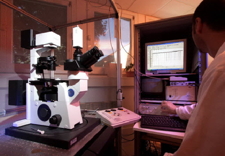 We use patch-clamp and imaging methods on living cells (HEK cells, cortical neurons in primary cultures) and isolated mitochondria. The lab is equipped with a patch-clamp setup consisting of an inverted Olympus IX 51 microscope + an Axoclamp 200B amplifier (Axon Instruments) + a motorized micromanipulator (Luigs & Neumann) + a pipette puller (DMZ Universal Puller, Zeitz Instruments). We use patch-clamp and imaging methods on living cells (HEK cells, cortical neurons in primary cultures) and isolated mitochondria. The lab is equipped with a patch-clamp setup consisting of an inverted Olympus IX 51 microscope + an Axoclamp 200B amplifier (Axon Instruments) + a motorized micromanipulator (Luigs & Neumann) + a pipette puller (DMZ Universal Puller, Zeitz Instruments). |